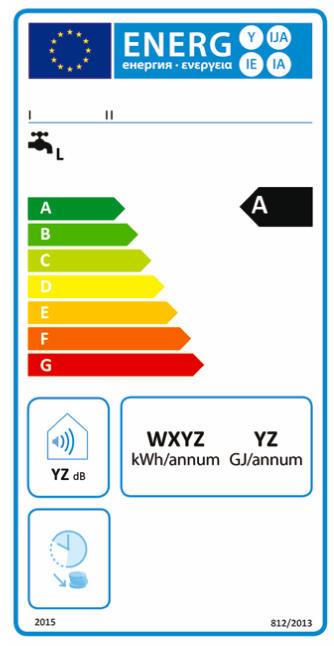Methodology
Topten.eu (Best products of Europe) presents the most energy efficient heat pump water heaters.
Scope
There are many different systems to supply domestic hot water (combined with space-heating, separate water heaters with a storage tank or instantaneous water heaters). The energy used varies from oil or gas boilers, to electrical resistance heaters or (electrical) air source heat pumps, to renewable sources like solar collectors, wood or industrial waste heat (often combined with space-heating as backup in winter and with electrical heaters in summer).
Heat pump water heaters are much more energy efficient than electrical resistance heaters, because they use electric heat pumps to extract heat from the surrounding air or from outside. The air source must not be from a heated room, since this would steal energy from the heating system. In Europe, every third domestic water heater is an electrical resistance heater. Around 4 million units electric water heaters are sold per year.
The most sustainable way of supplying domestic hot water is by using renewable energy like solar radiation. For some countries, solar water heating systems are presented on their Topten-site.
Technical criteria
All heat pump water heaters presented under www.topten.eu meet the following criteria:
- Energy class A+
- Measured according EN 16147: 2011
Click on the label for a larger view:

Data Sources
Manufacturers and suppliers
Order of presentation
The products are ranked by the eta value. The order of presentation can be changed.
Glossary
Brand, Model, Other models
Brand with link to website. Certified model for which the test report is provided. Similar models by the same brand that are also certified.
Volume in litres
Volume of the water heater
Electric heating in kW
An additional electric heating element allows the water to heat up at about twice the speed and to higher temperatures than by operating with the heat pump only. The temperature is normally set to 65°C.
Additional heat exchanger
Here, the boiler can be connected for fast heating and for covering peaks in hot water demand. Another option is to connect solar collectors.
Air duct
Air ducts allow to supply (and conduct) the air from outside or the next room. The supplied air serves as heat source and cools down in the process.
COP Coefficient of performance
The COP describes the ratio of heat in tapped hot water to consumption of electricity. Higher COP value means better performance. Tested according to EN 16147:2011.
Load profile
EN 16147 gives a choice of five load profiles (S, M, L, XL and XXL) under which the COP can be tested. Take a look at the table here.
Ambient temperature storage tank
Ambient temperature storage tank in °C. Both test standards give the following choice of test conditions for the COP test: 15°C for indoor air, 20°C for outdoor air and exhaust air.
Temperatures source / water
Temperature of heat source (air), temperatures of cold inlet water and hot water in °C. The test standards prescribe the temperature of air and cold inlet water as in the following table. The hot water temperature is a test result.
|
EN 16147:2011
|
Temperature of heat source:
Outdoor air
Indoor air
Exhaust air
|
7 °C
15 °C
20 °C
|
| Temperature of cold inlet water
|
10 °C
|
Sound
Sound power level indoors in dB(A)
Infoplus
Standards and Labels
- Commission delegated regulation (EU) No 812/2013 (EU energy label) of 18 February 2013 supplementing Directive 2010/30/EU of the European Parliament and of the Council with regard to the energy labelling of water heaters, hot water storage tanks and packages of water heater and solar device.
- Commission regulation (EU) No 814/2013 (EU ecodesign regulation) of 2 August 2013 implementing Directive 2009/125/EC of the European Parliament and of the Council with regard to ecodesign requirements for water heaters and hot water storage tanks; applies from 26 September 2015.
- Amendment regarding Online Energy Labels: Regulation No. 518/2014
- EHPA European Heat Pump Association, Brussels
- EN 16147: 2011. Heat pumps with electrically driven compressors - Testing and requirements for marking of domestic hot water units.
Links
- The European council for an energy efficient economy eceee provides a status overview on all products in the Ecodesign & Energy Labelling process
- Coolproducts informs about the EU ecodesign process on water heaters and other products. It is a coalition of NGOs' campaign for a stronger, fast Ecodesign Directive to save the climate and money.
- ECOS (Ecostandard) is an international NGO with a network of members and experts advocating for environmentally friendly technical standards, policies and laws.
- EPREL (European Product Registry for Energy Labelling) is the European product database. Products with an energy label are registered in EPREL in order to provide consumers with detailed product information.
Producers and suppliers are kindly asked to contact info(at)topten.info to register products which meet the Topten selection criteria.
09/2022 Hepp, Nipkow
 Viessmann Vitocal 262-A T2E
Viessmann Vitocal 262-A T2E Oertli TWH 250EH Pro
Oertli TWH 250EH Pro Atlantic Suisse AG WPA 303 ECO-2
Atlantic Suisse AG WPA 303 ECO-2 Peter Wärmepumpen Heatmaster AP 452
Peter Wärmepumpen Heatmaster AP 452 Oertli TWH 250E Pro
Oertli TWH 250E Pro